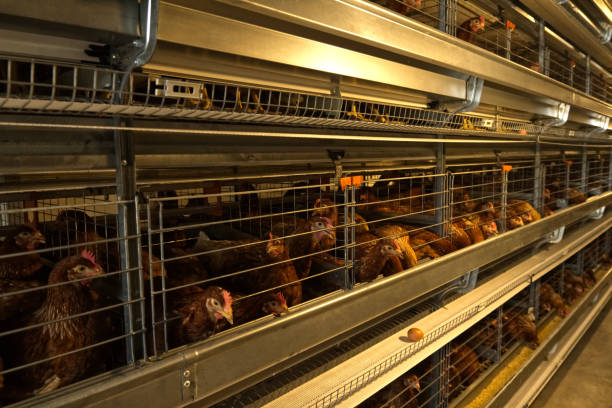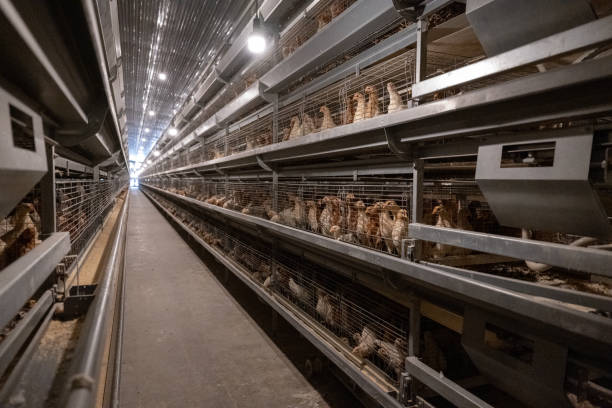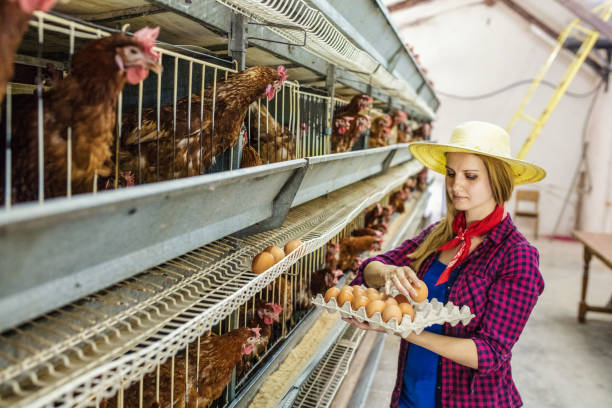Investing in High-Yield Battery Cages: A 20,000 Hen Guide for Tanzanian Farmers
Investing in High-Yield Battery Cages: A 20,000 Hen Guide for Tanzanian Farmers
Tanzania’s poultry sector is ripe with opportunity. The demand for eggs and chicken meat is consistently on the rise, driven by population growth, urbanization, and increasing disposable incomes. For aspiring or expanding poultry farmers in Tanzania, the prospect of managing a 20,000-hen operation can seem both exciting and daunting. Successfully scaling to this level necessitates careful planning, significant investment, and a keen understanding of modern poultry farming techniques. This guide specifically focuses on the strategic use of high-yield battery cages as a cornerstone of a profitable 20,000-hen egg production system in the Tanzanian context. We’ll explore the advantages of battery cages, address common concerns, and provide actionable insights to help you make informed decisions and maximize your returns.

Understanding the Tanzanian Poultry Market
Before diving into the specifics of battery cages, it’s crucial to understand the landscape of the Tanzanian poultry market. Several factors influence profitability, including:
Demand: Egg consumption habits are evolving in Tanzania. While traditional markets are still important, modern retail outlets are gaining traction, creating avenues for higher-quality, consistently supplied eggs.
Feed Costs: Feed represents the largest expense in poultry farming. Accessing affordable and nutritious feed is paramount. Consider establishing relationships with reliable feed suppliers or even exploring the possibility of producing your own feed. Always prioritize quality over just price, as poor-quality feed directly impacts egg production and hen health.
Market Access: How will you sell your eggs? Identifying your target market is essential. Will you focus on local markets, supply supermarkets, or target restaurants and hotels? Each option requires a different approach to grading, packaging, and distribution.
Competition: Understand the existing poultry farms in your area. What are their strengths and weaknesses? How can you differentiate your operation to gain a competitive edge?
Government Regulations: Stay informed about local and national regulations concerning poultry farming, including zoning laws, environmental regulations, and biosecurity protocols.
Why Choose Battery Cages for a 20,000-Hen Operation?
Battery cages, while sometimes controversial, offer significant advantages for large-scale egg production, especially in environments like Tanzania where land and resources might be limited. These advantages directly translate to improved profitability and scalability.
Increased Stocking Density: Battery cages allow for a significantly higher stocking density compared to floor systems or free-range farming. This means you can house more hens within the same area, maximizing your production output per square meter. This is particularly important in areas where land is expensive or scarce.
Improved Hygiene and Disease Control: The design of battery cages facilitates better hygiene and disease control. Hens are separated from their manure, reducing the risk of disease transmission. The cages are also easier to clean and disinfect, minimizing the buildup of pathogens. Proper ventilation systems in the poultry house further contribute to a healthier environment.
Reduced Egg Breakage: Eggs roll out of the cages and onto collection trays, minimizing the chances of breakage caused by hens stepping on them. This translates to significantly higher marketable egg yields.
Easier Egg Collection: Egg collection is simplified and streamlined in battery cage systems. Eggs are typically collected automatically, reducing labor costs and improving efficiency.
Reduced Feed Wastage: Battery cages minimize feed wastage, as hens have limited access to scatter feed around. This contributes to a lower feed conversion ratio (FCR), meaning you need less feed to produce the same number of eggs.
Better Monitoring and Management: Battery cages allow for easier monitoring of individual hens. You can quickly identify sick or unproductive birds and take appropriate action. This facilitates better flock management and overall health.
Choosing the Right Battery Cage System
Selecting the right battery cage system is a critical decision that will impact your operation’s efficiency and profitability for years to come. Here are key factors to consider:
Cage Material: Opt for high-quality galvanized steel cages or those with anti-corrosion coatings. These materials are durable, rust-resistant, and easy to clean, ensuring a long lifespan for your investment. Many suppliers also offer plastic options for floors or other cage components. Compare the cost-effectiveness and durability of each material.
Cage Size and Design: Ensure the cage size and design are adequate for the breed of hens you intend to raise. The cages should provide enough space for hens to move comfortably, stand, turn around, and access feed and water. Consider the number of hens per cage. Overcrowding can lead to stress, reduced egg production, and increased disease susceptibility.
Automatic Systems: Invest in automatic feeding, drinking, and egg collection systems. These systems significantly reduce labor costs, improve efficiency, and ensure consistent feed and water delivery. Automatic manure removal systems are also highly recommended for maintaining hygiene and minimizing labor.
Ventilation and Lighting: Adequate ventilation is critical for maintaining a healthy environment within the poultry house. Good ventilation removes ammonia and other harmful gases, regulates temperature, and provides fresh air. Lighting is also crucial for egg production. Implement a lighting program that mimics natural daylight cycles.
Durability and Maintenance: Choose a cage system that is built to last and easy to maintain. Consider the availability of spare parts and the ease of repairs. Regular maintenance is essential for ensuring the longevity and optimal performance of your cage system.
Supplier Reputation and Support: Select a reputable supplier with a proven track record of providing high-quality equipment and excellent customer support. Look for a supplier who can offer installation assistance, training, and after-sales service. Check customer reviews and testimonials to assess the supplier’s reliability and responsiveness.
Addressing Concerns About Battery Cages
Battery cages have often faced criticism due to animal welfare concerns. It’s important to acknowledge these concerns and consider strategies to mitigate them:
Enriched Cages: Consider investing in enriched battery cages. These cages provide hens with more space, perches, nest boxes, and scratching areas, allowing them to express more natural behaviors.
Proper Management Practices: Implement proper management practices to ensure the well-being of your hens. This includes providing adequate feed and water, maintaining a clean and hygienic environment, and monitoring hen health closely.
Training and Education: Train your staff on proper hen handling techniques and the importance of animal welfare. Educated staff are better equipped to identify and address potential problems.
Biosecurity Measures: Implementing strict biosecurity measures is crucial for preventing disease outbreaks. Control access to the poultry house, implement disinfection protocols, and vaccinate hens against common diseases.
Ethical Considerations: Consider the ethical implications of your farming practices. While battery cages offer economic advantages, strive to balance profitability with animal welfare. Transparency with consumers about your farming practices can also build trust and enhance your brand reputation.
Financial Planning and Investment
Investing in a 20,000-hen battery cage operation requires significant capital. Develop a detailed financial plan that outlines all expected costs and revenues.
Capital Costs: Include the cost of land, building construction or renovation, battery cage system, feeding and watering systems, egg collection system, manure removal system, ventilation and lighting systems, and other equipment.
Operating Costs: Include the cost of feed, chicks, vaccines, medications, electricity, water, labor, and transportation.
Revenue Projections: Estimate your egg production based on the breed of hens you are using and their expected laying rate. Project your egg sales based on your target market and the prevailing market prices.
Funding Sources: Explore various funding options, including bank loans, government subsidies, and private investors. Develop a compelling business plan to attract potential investors.
Sourcing Quality Chicks and Feed
The quality of your chicks and feed will directly impact your egg production and profitability.
Chicks: Source your chicks from a reputable hatchery that provides healthy, vaccinated chicks. Choose a breed that is well-suited to the Tanzanian climate and market demands. Preferably a breed renowned for high egg production and disease resistance.
Feed: Develop a feeding program that meets the nutritional needs of your hens at each stage of their life cycle. Work with a qualified nutritionist to formulate a balanced and cost-effective feed ration. Consider the availability and cost of different feed ingredients in your area.
Key Considerations for Tanzanian Farmers
Adapting your poultry operation to the specific challenges and opportunities of Tanzania is crucial for success.
Climate: Tanzania’s climate can be hot and humid. Ensure your poultry house is well-ventilated and insulated to maintain a comfortable temperature for your hens. Consider using evaporative cooling systems to reduce heat stress.

Reliable Water Supply: Access to a reliable and clean water supply is essential. Consider digging a borehole or installing a water storage tank to ensure a consistent supply of water, especially during the dry season.

Electricity: Intermittent electricity supply can be a challenge in some areas of Tanzania. Invest in a backup generator to ensure uninterrupted power supply for your automated systems. Consider exploring renewable energy options such as solar power.
Labor: Access to skilled labor is important. Train your staff in modern poultry farming techniques and provide them with ongoing education and support.
Biosecurity: Implement strict biosecurity measures to protect your hens from disease outbreaks. Work with a veterinarian to develop a comprehensive biosecurity plan.
Community Relations: Build positive relationships with your local community. This can help you gain access to land, labor, and markets.
Conclusion: A Profitable Future in Egg Production
Investing in a 20,000-hen battery cage operation in Tanzania can be a highly profitable venture. By carefully planning your operation, choosing the right equipment, implementing best management practices, and addressing potential challenges, you can build a successful and sustainable poultry farm that contributes to the growth of the Tanzanian economy and provides a valuable source of protein to the local population. Remember to continually adapt to changing market conditions, embrace innovation, and prioritize the well-being of your hens to ensure long-term success. The Tanzanian egg market offers significant potential for growth, and with careful planning and execution, you can establish a thriving poultry business that provides a reliable source of income and contributes to food security in the region. Embrace modern farming techniques, invest in quality equipment, and prioritize sustainable and ethical production practices to unlock the immense potential of the Tanzanian poultry sector.





